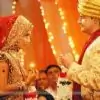We have all heard those pearls of wisdom from Prof Anthony Gonsalves in Amar Akbar Anthony: "You see the whole country of the system is juxtaposition by the haemoglobin in the atmosphere because you are sophisticated rhetoricians intoxicated by the exuberance of your own verbosity!" If that was not cheesy enough, here's Amitabh Bachchan again, as Arjun Singh in Namak Halal: "Arrey, aisi English aawye sir, that I can talk English, I can walk English, I can laugh English, I can run English, because English is a very phunny language. Bhairon becomes Byron and Byron becomes Bhairon because their minds are very narrow. In the year 1929 sir, when India was playing Australia..."
Not much sense can be made of this gibberish. But these lines stand out as classic examples of how English can be used intelligently in Hindi films to not only raise a laugh, but take a plot further with dramatic effect. They also count for some of the most memorable lines ever spoken by Bachchan in his career.
There were of course, others as well, such as Utpal Dutt (known for the way he chewed on certain words like "foolish") and Ajit (of "liquid oxygen" and "loin" fame) who liberally peppered their dialogues with English words and phrases which served as distinct calling cards and to a large extent, helped strengthen their image in public eye. They did not use expressions like "tension nahin lene ka" or "main like karta hoon" like present-day actors are doing on screen.
The indiscriminate use of English in Hindi cinema is a malady associated with the multiplex era. It begins with the very title of a film: Life... In A Metro, Heyy Baby, Rock On, Welcome, Love 2050, Kidnap, A Wednesday, Heroes, Roadside Romeo, Fashion... In that off-chance when a proper Hindi title like Om Shanti Om or Taare Zamin Par comes up, it is promptly shortened as OSO or TZP. This is how the film gets known later ~ the way Dilwale Dulhaniya Le Jayenge is today identified by its acronym, DDLJ.
At times this abbreviated form gets compressed further. Thus Kuch Kuch Hota Hai turns into K2H2 and Kabhi Khushi Kabhie Gham becomes K3G. No doubt such titles sound hip, look smart on billboards and are easy to recall. But this is almost like renaming a film, simply because the original title in Hindi creates the impression of being too desi and downmarket. Nowhere in the world are filmmakers as desperate to appear anglicized while misleading the cinegoer with distorted film titles. At this rate, they could even turn Kaagaz Ke Phool into K2P!
This is however, understandable. It leads our filmmakers into believing they are getting one step closer to 'Big Brother' Hollywood. But how would anybody explain the rampant use of English slang, bridge words, phrases and even entire sentences as a manner of speech when suitable alternatives can easily be found in Hindi? A recent case in point is Kareena Kapoor famously telling Shahid Kapoor in Jab We Met: "Main apni favourite hoon ~ chulbuli, delightful and full of life Punjaban kudi!"
It does not stop here. Katrina Kaif, a British girl, who cannot speak Hindi to save her life, is today, Bollywood's top-earning actress. Salman Khan knows his Hindi well, but deliberately speaks with an upper-class English accent. Himesh Reshammiya insists on pronouncing "Hari Om" as "Hurry Om" in Karzzzz. Shah Rukh Khan, Akshay Kumar, John Abraham and every other actor worth his salt are going about saying, "Hey dude", "Chill man" and "That's rocking" in order to establish how hep and anglicised they are. Even in an unglamorous film like Gangajal, we hear crude, rustic characters, mouthing lines like, "Aapka game over ho jayega aaj" and "Aapka mind toh kharab nahi ho gaya?"
This over-dependence on the English language could perhaps be explained as a delayed hangover from our colonial past. But that would be too simplistic, if not misleading. A more credible explanation is that the current crop of Bollywood dialogue writers are severely handicapped in their language skills and need to disguise their inadequacy by borrowing freely from English. Another possibility is their belief that the corrupted or hybridized form of Hindi ('Hinglish', as they say) carries a snob value and must be necessarily incorporated in all dialogues, regardless of whether it suits a character or not. A third possibility is that the present lot of actors and actresses is much more westernized than the earlier generation and incapable of grappling with the nuances of pure colloquial Hindi. It can also be argued that Hinglish is currently the preferred language of interaction among the youth and since the press, radio, television and advertising have already caught on to it, why should films be left behind?
There is a bit of truth in each of these assumptions. The film industry is today peopled with professionals who are not only highly qualified and trained in their jobs, but are exposed to western trends in filmmaking. Their familiarity with their roots or culture is at best perfunctory. Most importantly, the ones calling the shots now are all young ~ in the same age group of their target audience. They think alike, speak the same lingo and their concerns are similar.
The script or dialogue writer on the sets is no longer a bidi-smoking fuddy-duddy with a track record in mushairas and kavi sammelans. He is typically a smart young man in his thirties with a university degree behind him and some experience in radio, television or advertising. Nobody raises an eyebrow when this man, equipped with a laptop, discusses a script with flow charts, plots the 'graph' of his characters with an Excel spreadsheet and eventually hands over a bound volume of the film's dialogues typed in Roman script. Present-day actors and actresses are eminently at home with such people. What matters ultimately to everybody is whether the dialogue writer (indeed, lyricists as well) is capable of communicating with the audience. And the rest be damned!
The other way of looking at the issue is to recognize the fact that Hindi has never been a strong point for Bollywood films. While Bengali, Tamil, Telugu and all other cinemas are firmly rooted to the soil, the Hindi film industry could never find a home in the region (ideally, north or central India) where it belongs. It remains located in a predominantly Marathi-speaking area. Thus, with the advent of sound in Alam Ara in 1913 most actors were speaking Hindi with a strong Marathi accent. After Partition and the influx of talent from across the border, the influence of Persian-Hindi was discernible. Punjabi-Hindi has been yet another strong influence off and on. Effectively, the Hindi spoken in Bollywood films has always been a muddle of many linguistic strains of no definite origin. Had the industry been located in say, Uttar Pradesh or Delhi, we would probably be hearing more of Khari Boli ~ if not Bhojpuri ~ today.
What needs to be appreciated though is the way the language has kept pace with the times. Rather than remaining rigid to a certain set linguistic structure, grammar or idiom (for the sake of preserving its "purity"), the Hindi of our cinema has been alive to trends in social conduct, echoing public sentiments and accordingly, expanding its vocabulary ~ to the extent of incorporating foreign expressions. For instance, we now have a Hindi film with a Russian sounding title, Dasvidaniya. In comparison, the English (or Hinglish) used is a minor incongruity, if it can be called one. Besides, we all know that when a title like Fashion is pitted against say, Deshdrohi, the former that stands a far better chance of pulling in the crowds.
Ultimately, it is public perception that matters most for a film's success.





















0